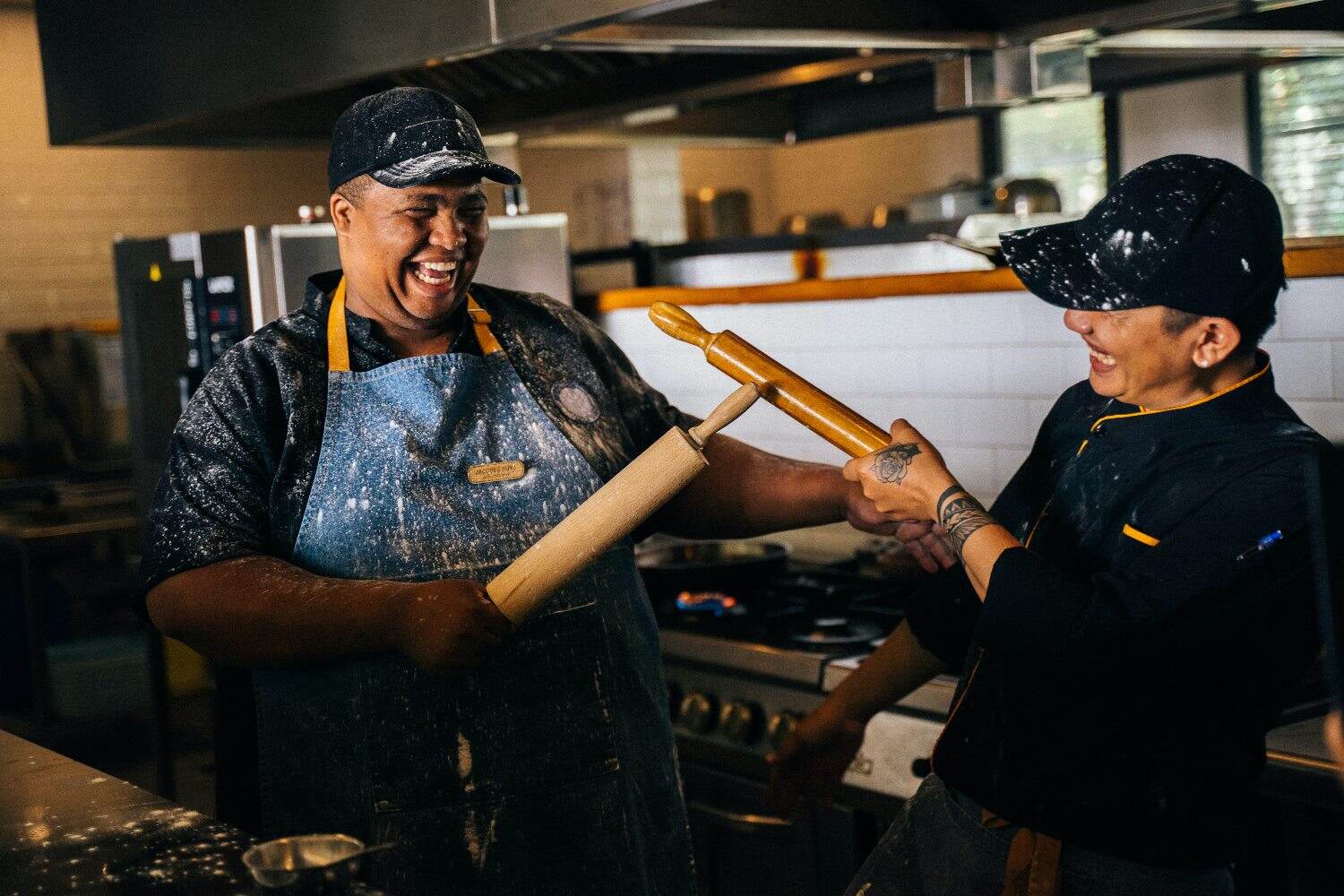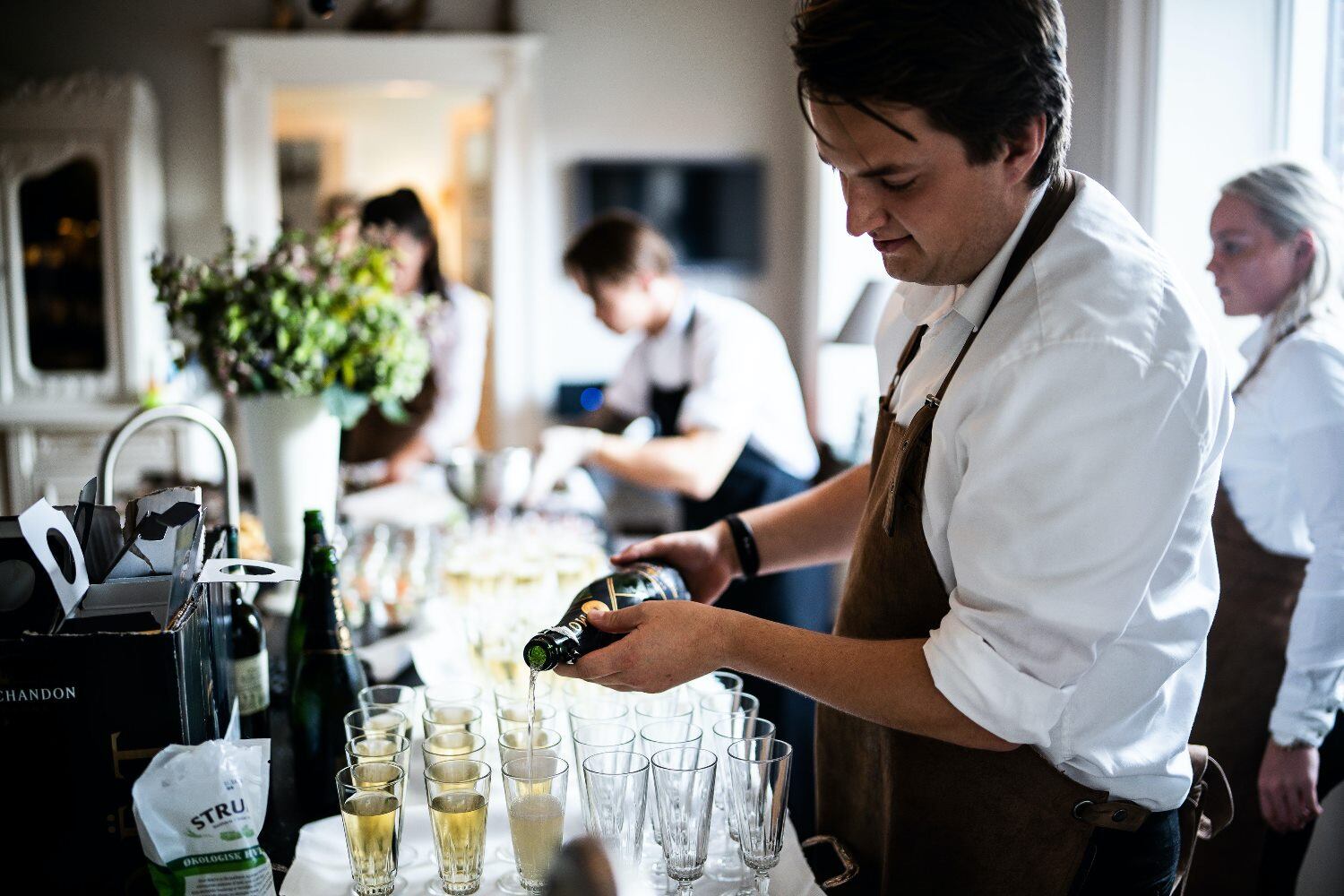Ah, the bustling world of restaurants! A place where the aroma of freshly cooked meals mingles with the chatter of patrons, and the clatter of dishes creates a symphony with the sizzle of the grill. But beneath this façade of harmony, like the simmering pot on a stove, conflicts can boil, threatening to spill over and disrupt the rhythm.
Having spent years in the restaurant industry, from being a wide-eyed waiter at a local diner to managing upscale bistros in the city, I’ve seen my fair share of disagreements and disputes. The world of culinary delights isn’t devoid of its challenges. Whether it’s a chef at loggerheads with the waitstaff over a mixed-up order, or a customer’s displeasure at a delayed dish, conflicts in a restaurant are as common as the daily special. And believe me, addressing these conflicts requires more finesse than perfectly flipping a pancake.
Why, you ask? Because restaurants are more than just establishments serving food. They are places where memories are made, where celebrations happen, where first dates lead to forever stories. A single unresolved conflict can sour a patron’s experience, leading to negative reviews and, worse, lost repeat business. On the other side, internal disputes can demotivate staff, leading to reduced productivity and increased turnover.
But fear not, for every challenge there’s a solution, and having navigated these choppy waters myself, I’m here to share some tried and tested strategies to manage conflicts in a restaurant setting effectively. So, fasten your apron, sharpen your knives, and let’s dive deep into the art of conflict resolution, restaurant-style!
The First Bite: Grasping the Heart of the Problem
Identifying the Root Cause of the Conflict
We’ve all heard the saying, “A stitch in time saves nine.” Well, in the world of restaurants, understanding a problem in its infancy can prevent a full-blown crisis. Let me take you back to a chilly evening at “La Bella Cucina,” one of the upscale restaurants I managed.
A regular patron, Mrs. Richardson, known for her love of our signature ravioli, sent her dish back to the kitchen, not once, but thrice. On the surface, it seemed she was displeased with the meal, but on probing, we discovered that her dissatisfaction stemmed from a past incident where her reservation was mixed up. The ravioli was just an outlet for her lingering resentment. This taught me a valuable lesson: conflicts are often symptoms of deeper issues. It’s imperative to dig deep and identify the root cause rather than just addressing the surface complaint.
Differentiating Between Internal and External Conflicts
While Mrs. Richardson’s case was an external conflict involving a customer, restaurants are also rife with internal disputes. Remember Jake and Rosa? Jake, our head chef, passionate about his culinary creations, and Rosa, our lead server, who’s on the frontlines, interacting with patrons. Their worlds clashed one evening over a dish modification request. Jake saw it as tampering with his masterpiece, while Rosa viewed it as meeting customer preferences. Two sides of the same coin, but a world of difference in perspectives.
It’s crucial to discern whether a conflict is internal, among the staff, or external, involving customers. Each requires a unique approach. Internal conflicts can affect team morale and need swift resolution to maintain a harmonious work environment. External conflicts, on the other hand, can impact a restaurant’s reputation and demand a blend of diplomacy and customer service skills.
Lending an Ear: The Power of Listening
I cannot emphasize enough the transformative power of simply listening. It was a bustling Friday night, and I noticed one of our junior chefs, Liam, visibly upset. Instead of reprimanding him for the dip in his performance, I chose to listen. Turns out, Liam was grappling with personal issues which spilled over to his work. Just the act of being heard made a world of difference to him.
Whether it’s a disgruntled customer, a stressed-out chef, or a server having a bad day, taking the time to listen can work wonders. It shows them that they’re valued and their concerns matter. By actively listening, you’re not just gathering information but also building trust, which is a cornerstone for effective conflict resolution.
In the echoing chaos of clinking glasses, sizzling pans, and overlapping conversations, it’s easy to overlook the whispers of brewing conflicts. But by understanding the problem, differentiating its nature, and genuinely listening, restaurants can master the recipe for harmony and success. As we journey further, we’ll arm ourselves with even more strategies to keep conflicts at bay. Stay with me as we turn the page to the next chapter!
Crafting the Blueprint: Instituting a Conflict Management Plan
Laying the Foundation: Setting Up a Conflict Management Plan
Much like a meticulously planned menu that caters to varied palates, a restaurant requires a structured approach to tackle conflicts. A memorable evening at “Le Gourmet Bistro” springs to mind. Two servers, both exceptional in their roles, clashed over the allocation of tables during a particularly busy shift. The situation could have spiraled, but thanks to our preemptive conflict management plan, the issue was addressed and resolved before the dessert course was served.
A robust conflict management plan begins with clear guidelines. These guidelines should detail the steps to be taken when a conflict arises, ensuring that every team member, from the kitchen staff to the front-of-house team, knows the protocol. This not only speeds up the resolution process but also instills a sense of security among the staff, knowing that there’s a system in place to address their concerns.
Sharpening the Tools: Training in Communication and Conflict Management
Drawing from my years in the restaurant world, I’ve often found that conflicts stem from miscommunication or a lack thereof. At “Riverside Café,” I introduced a training program focusing on communication and conflict management skills. Let’s just say, the results were akin to the delightful fizz in a perfectly poured champagne.
Empowering staff with effective communication techniques helps in preventing misunderstandings. The training sessions, peppered with role-playing exercises, allowed the team to step into each other’s shoes, fostering empathy and understanding. Moreover, by equipping them with conflict management skills, we ensured that minor disagreements didn’t snowball into major disputes.
Nipping It in the Bud: Preventing the Escalation of Issues
It was a sunny afternoon, and the patio of “Sunset Grille” was buzzing. Amidst the laughter and clinking glasses, I noticed a patron’s furrowed brow. Without waiting for the situation to escalate, I approached the table, listened to their concerns about the delayed appetizer, and immediately took corrective action. This proactive approach not only salvaged the situation but also turned a potentially disgruntled customer into a loyal patron.
Prevention is always better than cure. In the fast-paced restaurant environment, it’s essential to be vigilant and address potential conflicts before they escalate. By fostering a culture of open communication, encouraging staff to voice concerns early on, and acting promptly, many conflicts can be diffused in their nascent stages.
In summary, a well-structured conflict management plan, combined with the right training and a proactive approach, can transform a restaurant from a potential battleground of conflicts into a harmonious symphony of culinary delights and satisfied patrons. As we continue our exploration, we’ll delve into the nuances of mediation and the art of finding solutions. Keep your forks and knives ready; the next course promises to be enlightening!
The Art of Neutral Mediation: Balancing Flavors in a Heated Kitchen
Calm Amidst the Culinary Storm: Keeping Emotions in Check
Imagine a bustling Friday evening at “La Bella Notte”, an Italian bistro I once managed. The air was fragrant with garlic, tomatoes, and simmering sauces. Amidst the clatter and sizzle, a heated exchange between our sous-chef and a server threatened to boil over. Such scenarios aren’t uncommon in the high-pressure world of gastronomy. But how we handle these moments can make all the difference.
In emotionally charged situations, it’s easy to let sentiments dictate actions. However, the key lies in taking a step back, deep breathing, and detaching oneself from the immediacy of the conflict. By doing so, we can approach the issue with a cooler head and clearer perspective. Emotions, like seasonings, must be kept in check to ensure the dish— or in this case, the resolution— is well-balanced.
The Unbiased Arbiter: Remaining Neutral during Mediation
At “Café Serenity”, where I was the general manager, we had a golden rule: “Leave personal biases at the door.” This was not just a catchy phrase but a mantra embedded in our conflict resolution approach.
When mediating conflicts, neutrality is of the essence. As a mediator, one must approach the situation as a blank slate, free from personal biases or preconceived notions. I recall an incident involving a bartender and a hostess, each with their version of events leading to a reservation mix-up. By ensuring neither party felt favored nor sidelined, we were able to facilitate a conversation that was constructive rather than confrontational.
Lending an Ear to All: Allowing Expressive Dialogue
An incident at “Bistro Harmonie” springs to mind. Two of our most talented chefs had differing views on a new menu item. Tensions reached a peak during a menu tasting session. Instead of dictating a solution, I invited both chefs to a private meeting. The only rule? Each person would speak uninterrupted, laying out their vision and concerns.
By allowing both parties to express their side of the story without interruption, we ensure that each feels heard and validated. It’s akin to tasting a dish in its entirety before passing judgment. More often than not, when individuals feel their perspective is acknowledged, they are more open to compromise and collaboration.
In conclusion, neutral mediation is much like crafting a perfect dish. It requires patience, a balanced approach, and the right ingredients— in this case, emotional restraint, unbiased mediation, and open communication. As we continue our journey through the bustling world of restaurant conflict management, we’ll delve into the intricacies of finding solutions and ensuring a harmonious work environment. Stay tuned; the next course is sure to be a delectable treat!
Cooking Up Solutions: Navigating the Gastronomic Labyrinth
Crafting the Perfect Dish: Identifying a Pleasing Solution
Years ago, I was part of “Le Gourmet Voyage”, a fine-dining establishment known for its fusion cuisine. But blending flavors wasn’t our only specialty. We also had a knack for blending ideas, especially during conflicts.
Finding a solution that satisfies everyone is akin to designing a dish that caters to diverse palates. It requires understanding each individual’s tastes and preferences, then crafting a resolution that incorporates these elements. For instance, when two of our servers had a disagreement about table assignments, we devised a rotating schedule. This ensured that both had access to the more lucrative sections on alternate days, balancing out potential earnings and ensuring fairness.
The Recipe for Clarity: Documenting the Decision
When I was at “Mystique Aromas”, a chic café known for its coffees, we had a saying: “If it’s not written, it’s not done.” This mantra emerged from a series of misunderstandings that could have easily been avoided with proper documentation.
Putting a solution in writing is essential. It serves as a clear reference point and minimizes the chances of future disputes. Consider it as documenting a secret recipe. Every ingredient (or term) needs to be explicitly stated, so there’s no ambiguity. For instance, after a heated discussion about overtime hours among our baristas, we not only agreed upon a solution but also documented the new overtime protocol. This ensured everyone was on the same page and curbed any potential disagreements down the road.
The Power of Togetherness: Team-Building Events
At “Sunset Grills”, where the ocean met the horizon, our seafood was a hit. But what truly set us apart was our cohesive team, a result of regular team-building activities.
Post a particularly challenging period, where miscommunication had led to service delays and customer dissatisfaction, we recognized the need for team synergy. We initiated team-building events, from culinary workshops to beach outings. These events allowed our staff to bond outside the high-pressure restaurant environment, understand each other better, and function as a cohesive unit.
I vividly recall a team-building cooking challenge where our front-of-house staff and kitchen brigade swapped roles. This exercise not only led to much laughter and camaraderie but also fostered a deep sense of empathy. Our servers got a firsthand experience of the kitchen’s pressures, and our chefs understood the challenges of interacting with diners. This mutual respect significantly reduced conflicts and enhanced our service quality.
To wrap up this segment, finding a solution in the restaurant business requires a mix of creativity, clarity, and camaraderie. As we stir the pot further in our exploration of conflict management, we’ll delve deeper into fostering a positive environment and the nuances of effective resolution. After all, a restaurant isn’t just about food; it’s about the people who bring it to life.
Culinary Harmony: Cultivating a Positive Kitchen and Dining Ambiance
Crafting an Uplifting Atmosphere: The Essence of a Positive Work Environment
Have you ever entered a restaurant and felt an unmistakable positive energy? I’ve been fortunate to experience this at “Harmony Plates”, a charming bistro tucked away in the heart of Paris. The secret ingredient to its success wasn’t just the mouth-watering escargot but the palpable camaraderie and optimism among the staff.
Creating a positive work environment in a restaurant goes beyond aesthetics. It’s about fostering a space where each team member feels valued, respected, and motivated. At “Harmony Plates”, the management made a concerted effort to recognize and appreciate individual contributions, from the chef’s culinary masterpieces to the janitor’s impeccable maintenance. This culture of acknowledgment and appreciation radiated positivity, making both the staff and diners feel cherished.
The Symphony of Open Dialogue: Encouraging Transparent Communication
During my stint at “Conversations Café” in New York, I learned the profound impact of open communication. Named aptly, this café thrived on conversations – not just among customers but also within its workforce.
Open communication is the lifeline of any successful restaurant. It allows for a free flow of ideas, feedback, and concerns. By holding regular staff meetings, “Conversations Café” ensured that everyone, from the head chef to the newest waiter, had a platform to voice their opinions and share insights. This practice not only nipped potential conflicts in the bud but also cultivated a sense of belonging. I remember an instance where a server’s suggestion to introduce a new vegan dessert led to the café’s most popular dish!
Setting the Table Right: Clear Guidelines on Conduct
“Ethical Eats”, located in the bustling lanes of Tokyo, stood out not just for its delectable sushi but its clear code of conduct. Every new team member, upon joining, was handed the “Ethical Eats Etiquette Guide” – a handbook delineating acceptable behavior and work ethics.
Clear guidelines on conduct are paramount in a restaurant setting. Given the high-pressure environment, it’s easy for conflicts to arise from misunderstandings or perceived slights. By establishing a clear code of behavior, “Ethical Eats” minimized ambiguity. The guide covered everything from punctuality, respectful communication, to handling customer grievances. This clarity ensured that every team member knew the expected standards, leading to a harmonious work environment.
In the world of gastronomy, while exquisite dishes are pivotal, the ambiance and dynamics among the staff play an equally crucial role. As we continue our journey through the restaurant realm, we’ll uncover strategies to effectively navigate conflicts and the fascinating nuances of the dining industry. After all, a well-functioning restaurant is much like a well-orchestrated symphony – each note, each player, crucial to the melody.
The Art of Reconciliation: Navigating Disagreements in the Culinary World
Dishing Out Options: The Power of Choices
I recall a fascinating incident at “Bistro Balance” in Rome. Two chefs, Leonardo and Maria, had a heated disagreement over the presentation of their signature risotto. Instead of letting this conflict simmer, the manager, Isabella, intervened. Rather than dictating a solution, she asked both chefs to present alternative plating styles. The result? A “duo risotto” dish that became an instant hit!
Generating options is a potent tool in conflict resolution. By providing alternatives, we move away from a “my way or the highway” approach to a more inclusive “let’s find a way together”. This not only allows for creative solutions but also ensures that everyone feels heard and valued.
Stepping Stones to Harmony: Breaking Down the Path to Consensus
During my time at “Pebble Path Café” in Melbourne, I was introduced to a unique approach to conflict resolution. Whenever a disagreement arose, the involved parties would list out “stepping stones” – small, actionable steps towards a mutually agreeable solution. For instance, when there was a debate over the café’s music selection, the team decided on stepping stones like creating a shared playlist, setting volume guidelines, and having themed music days.
By breaking down the resolution process into tangible steps, conflicts become less daunting. Each stepping stone acts as a milestone, ensuring that the path to consensus is clear and achievable.
Crafting Win-Win Deals: The Essence of Mutual Benefit Agreements
At the luxurious “Win-Win Dine” in Dubai, I witnessed the epitome of effective conflict resolution. A customer, Mr. Ahmed, was dissatisfied with his steak’s preparation. Instead of dismissing his concerns, the chef, Aisha, personally visited his table. After understanding his preferences, she not only offered a complimentary steak prepared to his liking but also asked for his input on potential menu additions. This transformed a potential negative review into a loyal customer and a culinary consultant!
Mutual benefit agreements hinge on the principle that conflicts can be turned into opportunities. By seeking solutions that benefit all parties, restaurants can foster loyalty, gather valuable feedback, and ensure that every diner leaves with a smile.
In the bustling world of restaurants, where the heat of the kitchen often spills over to interactions, mastering effective conflict resolution is paramount. As we delve deeper into the realm of culinary disputes, we’ll unearth strategies that not only quell disagreements but turn them into opportunities for growth and innovation. Stay tuned, for the kitchen holds many tales, and each dish has a story!
Behind the Scenes: Eye-Opening Insights into Restaurant Conflict Management
The culinary world might seem like all about delightful dishes, elegant décor, and pleasing ambience, but behind those kitchen doors, it’s a hotbed of passion, creativity, and, yes, inevitable conflicts. As we’ve dived into the intricacies of conflict management in the restaurant realm, let’s spice things up with some fascinating tidbits that you might not be aware of!
1. The Symphony of Spoons and Spats
Did you know that according to a study conducted by the Restaurant Management Institute, nearly 60% of restaurant conflicts arise from the kitchen? The pressure of delivering perfect dishes in record time often leads to disagreements among chefs, sous-chefs, and kitchen staff. It’s not just about the burnt soufflé; it’s about the harmony required to deliver hundreds of impeccable dishes night after night.
2. The Table Turn Tiff
One of the most common sources of conflict between restaurant servers and management is the “table turn time” – the time it takes for a group of diners to finish their meal and leave, making the table available for the next set of customers. It’s a delicate balance: rushing customers might impact service quality, while lingering diners can affect the night’s profits.
3. The Reservation Rumble
Reservations might seem straightforward, but they’re a significant conflict source. Double-booked tables, overbookings, or guests arriving late (or not at all) can cause chaos, leading to both internal disagreements and conflicts with customers.
4. Cultural Cuisines and Conflicts
In multi-cuisine restaurants or those with a diverse staff, cultural misunderstandings can lead to disputes. For instance, a chef trained in authentic Italian cuisine might conflict with another who believes in fusion dishes. Understanding and respecting culinary traditions becomes crucial.
5. The Customer Isn’t Always Right
Contrary to the popular saying, in restaurants, the customer isn’t always right. A survey revealed that 70% of conflicts in high-end restaurants arise from customers’ unrealistic demands or a lack of understanding of the dishes they’ve ordered.
6. The Social Media Soup
With the rise of social media, a new conflict dimension has emerged. Negative reviews, often exaggerated, can ignite internal blame games. The challenge is to address genuine concerns while ensuring that the team’s morale isn’t affected by every online critique.
7. The Tip Tug-of-War
In regions where tipping is customary, the distribution of tips can become a major conflict point. Who gets how much? Is it split equally, or based on roles? Many restaurants are now adopting pooled tip systems or service charges to mitigate such disputes.
Concluding Bites: Navigating the Culinary Clash
Restaurants, with their eclectic mix of flavors, aromas, personalities, and expectations, are more than just establishments serving food. They are theaters where daily dramas unfold, marked by highs of culinary triumphs and lows of simmering conflicts. However, as we’ve journeyed through the multifaceted world of restaurant conflict management, one thing is clear: conflicts, when addressed with care, understanding, and strategy, can lead to growth, innovation, and unparalleled team unity.
Understanding the root of disagreements, be it a miscommunication in the kitchen or a reservation gone wrong, is the first step to dishing out solutions. By arming oneself with effective conflict management strategies, from active listening to fostering a positive environment, restaurant managers and staff can ensure that the establishment runs smoothly. It’s about turning conflicts into constructive conversations, ensuring that every stakeholder, from the chef to the diner, feels heard, valued, and satisfied.
The restaurant industry, with its ever-evolving dynamics, will always have its share of challenges. But with the right approach, these challenges can be transformed into opportunities for learning, growth, and creating memorable experiences. After all, as in a perfectly balanced dish, it’s the harmony of contrasting elements that creates a masterpiece. So, the next time you step into a restaurant, remember that beyond the delightful dishes and ambient lighting, there’s a team constantly striving to manage, resolve, and learn from conflicts, ensuring that your dining experience remains nothing short of exceptional. Cheers to the unsung heroes of conflict resolution in the culinary world!




















